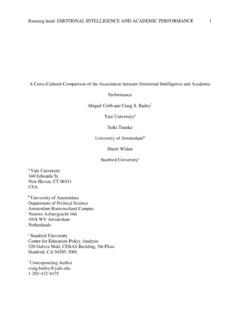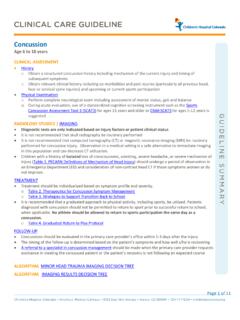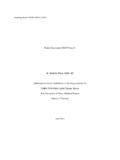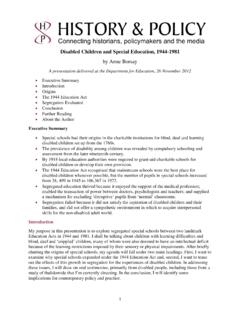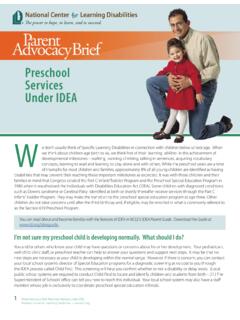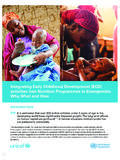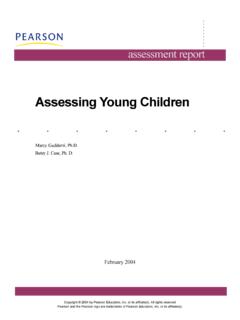Transcription of Sleep and Sensory Integration: A Guide for Parents
1 Sleep and Sensory integration : A Guide for Parents By Teresa A. May-Benson, ScD, OTR/L, FAOTA. and Spiral Foundation Interns About A. Jean Ayres, PhD, OTR, FAOTA, Founder of Sensory integration Theory A. Jean Ayres, occupational therapist, developed the Sensory integration frame of reference. Dr. Ayres was born in 1920 in Visalia, California. Growing up she struggled with everyday sensations that interrupted and impacted her ability to learn like her peers. Due to her difficult childhood, Ayres was determined to study the reasons why children like her had such difficulty with everyday tasks. She obtained a master's degree in occupational therapy and a doctorate in educational psychology from the University of Southern California. Dr. Ayres later completed postdoctoral work at UCLA's Brain Research Institute where she began to develop her theory of Sensory integration .
2 Through her work, Dr. Ayres found children with Sensory integration dysfunction had a neural disorder that affected their ability to interpret and process Sensory information, such as touch and movement. From this discovery, she developed assessment tools such as the Southern California Sensory integration Tests (SCSIT) and later the Sensory integration and Praxis Tests (SIPT) that helped occupational therapists identify this disorder in children . She created equipment and treatment techniques, which now serve as the foundation to Sensory integration intervention. This novel intervention approach changed the way occupational therapists treat children with Sensory and motor challenges. Dr. Ayres believed therapy should emphasize the power of sensations, be child-directed and be play-based to make the neural changes necessary to improve the child's ability to function in everyday life.
3 Throughout the past decades, Ayres' work has been the foundation for increased understanding of the relationship of Sensory processing, motor development and behavior in children . Her theory and terminology are used by many professions though they remain rooted in occupational therapy. Photo A Jean Ayres Jane Koomar. Used with permission. Sleep AND Sensory integration : A Guide FOR Parents . 2018 Spiral Foundation at OTA-Watertown All Rights Reserved. No part of this publication may be reproduced or transmitted in any form or by any means, electronic or mechanical, including photocopying, recording or any information storage and retrieval system, without permission in writing from the copyright owner Spiral Foundation at OTA-Watertown. Clip art and photographs used in this publication are either royalty free artwork obtained from a legally licensed copy of Microsoft Office Word 2010 for use by a non-profit organization or purchased from , courtesy of andresrimaging, EpicStockMedia, a-wrangler, 4774344sean, monkeybusinessimages, Johnnyhetfield, and omgimages.
4 Acknowledgements: Portions of this publication originally appeared on the Spiral Foundation website: and were adapted from material written for the website by Anne Trecker, MS, OTR/L. We would like to acknowledge contributions by: Linda Tirella, Amy Danato and Emelia Heckman. Printed in the United States of America PUBLISHED BY. Spiral Foundation at OTA-Watertown, 74 Bridge St. Newton, MA 02458 617-969-4410 2 |Page Spiral Foundation Table of Contents What Is Sensory integration (SI)? 4. How Does SI Impact Sleep ? . 5. Does My Child Have Sleep Challenges? A Checklist . 6. Common Sleep Problems in children .. 7. Co-Sleeping . 7. Trouble Falling Asleep . 7. Sleep Interventions .. 8. Creating & Maintaining Bedtime Routines .. 8. Getting Ready for Bed: Calming Pre-Bedtime Activities ..9. Changing the Sleep Environment.
5 10. Other Considerations ..10. Sleep Strategies ..11. Infants . 12. Back to Sleep ..12. Tummy Time .. 12. Sleep Challenges and Autism Spectrum Disorder .. 13. References & Resources: Where Can I Learn More? ..14. Appendix A: Assessment Tools..15. 3 |Page Spiral Foundation This guidebook was developed to provide an overview of Sleep and the impacts Sensory integration problems and Sensory processing disorder have on Sleep , strategies to help change Sleep patterns/routines, and assessment tools. Maybe your son or daughter Maybe your child has become What is Sensory struggles with sleeping and eating socially isolated because the integration ? and is irritable much of the day. You, as the parent, think that it is slightest touch feels threatening. only a stage, but that doesn't make it any easier to deal with.
6 Every day we experience and interpret Sensory information from our environment. This information comes from the senses: sight, hearing, touch, taste, and smell, as well as balance and movement (vestibular sense) and muscle and joint senses (proprioception). Our balance and movement sense allows us to know where we are in space and where our head is in relation to gravity. Our muscle and joint sense allows us to know about how much force we use and where our extremities are in relation to our body. All of these senses provide us with information about our body and the environment around us. The process by which the brain organizes and interprets this information from our senses is called Sensory integration . For most people, Sensory integration develops through typical childhood experiences.
7 Through these experiences, children acquire the ability to interpret, adjust and respond appropriately to incoming sensations. For example, children gain knowledge of their body in space through movement activities such as running , swinging and rolling. This knowledge allows them to navigate their world safely such as being able to safely time crossing a busy street. However, for some people, the ability to integrate everyday Sensory information does not develop as well as it should. It can result in long-term difficulties with everyday activities such as work, dressing, eating and self-regulation. When this occurs, the individual has a problem with Sensory integration . This problem is frequently referred to as a Sensory integration or Sensory Processing Disorder (SPD). Maybe your child is a good Maybe your child's ears fill with student who is determined to pain whenever the fire alarm rings work hard but can't seem to stay at school.
8 While everyone else goes organized or focused at their outside, all your child can do is curl desk. up with their hands over their ears. 4 |Page Spiral Foundation How Does Sensory integration Impact Sleep ? Sleep is an important part of our everyday lives. Our bodies need Sleep in order to stay healthy, think, move, interact, and feel our best. For many people it is difficult to fall asleep, stay asleep, or be comfortable while they are trying to Sleep ; 30% of children have trouble with Sleep (Vasak, Williamson, Garden, & Zwicker, 2015). One reason for these difficulties may be related to the way their bodies experience and react to the world around them. Stimuli (such as, sights, sounds, touch) may make it difficult for some children to make their bodies calm and relaxed. Researchers have discovered that there is a significant link between Sleep behaviors/patterns and the way bodies experience Sensory stimuli or sensations.
9 In particular, research has found that children who are sensitive to sights, touch, movement, and sound have greater difficulty with Sleep (Engel-Yeger & Shochat, 2012; Shochat, Tzischinsky, &Engel-Yeger, 2009). children with Sensory integration (SI) needs are more likely to have challenges falling asleep, staying asleep, and/or being comfortable while sleeping. Poor Sleep not only negatively impacts the child, but the whole family. If Sleep difficulties go unchecked, they can lead to later-life challenges such as negative behavior, poor self-regulation, and depression (Vasak, Williamson, Garden, & Zwicker, 2015). Sleep challenges increase if a child has SI challenges that co-occur with a diagnosis of ADHD, ASD, and/or intellectual disability (Breslin, Edgin, Bootzin, Goodwin2 & Nadel, 2011; Goldman, Richdale, Clemons & Malow, 2012).
10 Parenting styles, cultural values, sibling interaction, family stress, Sleep deprivation, occupational balance , napping, sleeping position, medical illness, Sleep disorders, psychiatric disorders, and behavioral/developmental difficulties also impact Sleep (Vasak, Williamson, Garden, & Zwicker, 2015). 5 |Page Spiral Foundation Does My Child Have Sleep Challenges? A Checklist The BEARS acronym is a very helpful way to check in about your child's Sleep : Bedtime: Does your child have difficulty falling asleep or going to bed by himself/herself? Excessive daytime sleepiness: Does your child have difficulty waking up or seem groggy or sleepy throughout the day? Awakenings at night: Does your child wake up at night? Can he/she fall back to Sleep by his/herself? Regularity: What is your child's typical bedtime and wake-up routine?
